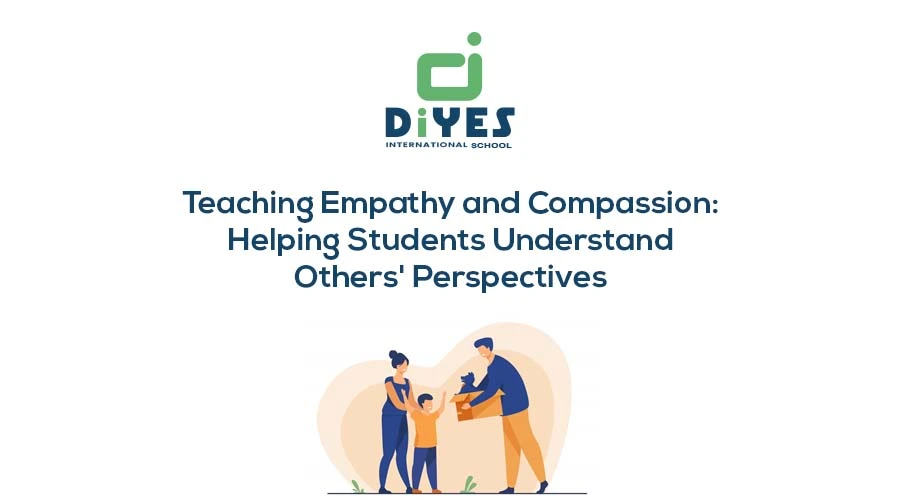In today’s interconnected world, empathy and compassion are critical skills for students to develop. These qualities not only nurture a sense of community but also enhance emotional intelligence, social skills, and overall well-being. This blog explores practical strategies for teaching empathy to elementary students, helping students understand others’ perspectives and cultivate meaningful, empathetic relationships.

Empathy and compassion are the bedrock of human connection, allowing us to understand and share the feelings of others. In educational settings, nurturing these qualities can significantly impact students’ social and emotional development. This blog delves into effective methods educators and parents can use to teach empathy and compassion, addressing the question of how you can teach empathy, ensuring students grow into considerate, understanding, and emotionally intelligent individuals. Additionally, we will highlight various empathy activities for students to further reinforce these essential skills.
Creating an Empathetic Classroom Environment
An empathetic classroom environment is crucial for nurturing empathy and compassion. Here are steps educators can take to create such an environment:
- Modelling Empathy: Educators should lead by example, demonstrating empathy in their interactions with students and colleagues. By showing genuine concern and understanding, teachers set a powerful precedent for students to follow. This involves being attuned to students’ emotional states and responding with care, which helps students feel valued and understood.
- Promoting Open Communication: Nurture an atmosphere where students feel safe to express their thoughts and feelings. Encourage open dialogue and active listening, emphasizing the importance of understanding different perspectives. This can be achieved through regular class meetings where students share experiences and discuss emotional topics in a supportive environment.
- Incorporating Social-Emotional Learning (SEL): Integrate SEL into the curriculum to teach students about emotions, empathy, and relationships. Use activities and discussions that focus on recognizing and understanding others’ emotions. SEL programs often include lessons on self-awareness, self-management, social awareness, relationship skills, and responsible decision-making, all of which are fundamental for developing empathy.
- Encouraging Cooperative Learning: Use group activities and projects to promote teamwork and cooperation. These collaborative efforts help students appreciate diverse viewpoints and develop empathy through shared experiences. Cooperative learning also teaches students how to communicate effectively, resolve conflicts, and work towards common goals.
By creating an empathetic classroom environment, educators can nurture a sense of community and mutual respect, laying the foundation for students to develop empathy and compassion naturally. This environment helps students feel connected and supported, which is essential for their emotional and social growth.
Utilizing Literature and Storytelling
Literature and storytelling are effective means for teaching empathy in students by helping them see the world from different perspectives. Here’s how these methods can help students:
- Choosing Diverse Books: Select books that feature diverse characters and experiences. Stories that explore different cultures, backgrounds, and situations help students see the world through others’ eyes. Diverse literature provides a mirror for students to see themselves and a window to understand others, nurturing empathy and broadening their worldview.
- Facilitating Reflective Discussions: After reading, engage students in discussions about the characters’ feelings, motivations, and challenges. Encourage them to think deeply about how they would feel in similar situations. Reflective discussions can feature prompts such as, “What emotions do you think the character experienced when…?” or “If you were in the character’s situation, how would you react?”
- Role-Playing Activities: Use role-playing to help students step into the shoes of various characters. This active engagement promotes a deeper understanding of different perspectives and nurtures empathy. Role-playing can be extended to include improvisational scenarios where students must react to new developments as their characters, further enhancing their empathetic skills.
- Creative Writing Exercises: Encourage students to write stories from the viewpoints of characters different from themselves. This exercise challenges them to think critically about others’ experiences and emotions.

Creative writing assignments can include diary entries, letters, or alternative endings that require students to deeply consider the thoughts and feelings of their characters.
Through literature and storytelling, students can explore a wide range of human experiences, developing a deeper understanding and empathy for others. These activities not only enhance their reading and writing skills but also cultivate their ability to connect with and understand people from all walks of life.
Encouraging Perspective-Taking
Perspective-taking is a key component of empathy. Here are strategies to help students practice this essential skill:
- Using Real-Life Scenarios: Present students with real-life situations that require them to consider multiple perspectives. Discuss these scenarios and explore the emotions and thoughts of all parties involved. For example, a scenario about a playground conflict can be used to discuss how each child involved might feel and what motivations might be behind their actions.
- Empathy Mapping: Use empathy maps to help students visualize and understand others’ experiences. This tool encourages them to consider what others might be thinking, feeling, and experiencing. Empathy maps can be used in various subjects, such as history or social studies, to explore the perspectives of historical figures or contemporary people facing different challenges.
- Mindfulness Practices: Incorporate mindfulness exercises that focus on empathy and compassion. Practices such as loving-kindness meditation can help students develop a more empathetic mindset. Mindfulness activities can also include guided visualizations where students imagine themselves in different situations, nurturing emotional connection and understanding.
- Interactive Activities: Engage students in activities like “Walk in Someone Else’s Shoes,” where they literally or figuratively experience a day in the life of another person. These activities promote empathy through experiential learning. Interactive activities can also involve community visits or virtual exchanges with students from different backgrounds to broaden their understanding of others’ lives.
Encouraging perspective-taking helps students move beyond their own experiences and develop a genuine understanding and empathy for others. This skill is crucial for their social and emotional development, helping them build stronger, more compassionate relationships throughout their lives.
Nurturing a Culture of Kindness and Compassion
Cultivating a culture of kindness and compassion in schools is essential for teaching empathy. Here are ways to promote these values:
- Recognizing Acts of Kindness: Create opportunities to acknowledge and celebrate acts of kindness within the school community. Recognizing compassionate behaviour reinforces the importance of empathy. Implement a “kindness wall” where students can post notes about acts of kindness they have witnessed or experienced, creating a visual representation of the community’s empathy.
- Service-Learning Projects: Involve students in service-learning projects that address community needs. These projects provide hands-on experiences in helping others and understanding their struggles.

Service-learning projects can include activities like volunteering at local shelters, organizing food drives, or participating in environmental clean-ups, all of which help students connect with their communities and practice empathy.
- Peer Support Programs: Implement peer support programs where students help each other through challenges. These programs nurture a sense of responsibility and empathy among students. Peer mentoring and buddy systems can be used to support new students, those facing academic challenges, or anyone needing a friend, creating a network of empathy and support.
- Gratitude Exercises: Encourage students to practice gratitude by reflecting on the kindness they receive and the kindness they give. Gratitude nurtures positive emotions and a compassionate outlook. Activities like keeping a gratitude journal or writing thank-you notes can help students focus on the positive aspects of their lives and the people who contribute to them.
By nurturing a culture of kindness and compassion, schools can create a supportive environment where empathy and understanding flourish, benefiting the entire community. This culture not only enhances the school climate but also prepares students to be empathetic, compassionate individuals in all areas of their lives.
Engaging Parents and the Community
Teaching empathy and compassion extends beyond the classroom. Here’s how to involve parents and the community in this important endeavour:
- Parent Workshops: Offer workshops that educate parents on the importance of empathy and how to reinforce these skills at home. Provide them with resources and strategies for nurturing empathy in their children. Workshops can include role-playing activities, discussions on empathetic communication, and techniques for modelling empathy at home.
- Community Service Initiatives: Organize community service events that involve students, parents, and community members. Working together to help others strengthens community bonds and nurtures empathy. These initiatives can range from local clean-up projects to larger campaigns addressing issues like homelessness or environmental sustainability.
- Collaborative Projects: Engage parents and community members in collaborative projects that promote empathy and compassion. These projects provide opportunities for intergenerational learning and mutual understanding. Examples include community gardens, intergenerational storytelling events, and cultural exchange programs, all of which bring people together and enhance empathy.
- Open Communication Channels: Maintain open communication with parents about the importance of empathy and how it is being addressed in the classroom. Regular newsletters, parent-teacher meetings, and social media updates can keep parents informed and involved in their children’s empathetic development.
Engaging parents and the community in teaching empathy creates a unified approach, ensuring that students receive consistent messages about the value of understanding and compassion both at school and at home. This collaborative effort reinforces the importance of empathy in all areas of life and helps build a more compassionate community.
Conclusion
Empathy and compassion are not innate qualities but skills that can be taught and nurtured. By creating empathetic classroom environments, utilizing literature and storytelling, encouraging perspective-taking, nurturing a culture of kindness, and engaging parents and the community, we can help students develop these essential traits. The benefits of nurturing empathy and compassion extend far beyond the classroom, contributing to a more understanding, supportive, and connected society.
In a world increasingly marked by division and misunderstanding, the ability to empathize and show compassion is more important than ever. As educators and parents, it is our responsibility to equip the next generation with the tools they need to navigate diverse social landscapes and build meaningful relationships. By prioritizing empathy and compassion in education, we lay the groundwork for a more empathetic, compassionate, and harmonious future.
Teaching empathy and compassion is not a one-time lesson but a continuous journey. It requires dedication, creativity, and a willingness to model these qualities in our daily interactions. As we guide students through this journey, we help them develop the emotional intelligence necessary to thrive in an interconnected world. Ultimately, nurturing empathy and compassion enriches not only the lives of students but also the fabric of our society as a whole.
In conclusion, let us commit to nurturing empathy and compassion in our students. By doing so, we empower them to become not just successful individuals, but also kind, empathetic, and compassionate members of society. Together, we can make a profound impact, creating a world where understanding and kindness prevail.
At DiYES International School, we believe in the transformative power of empathy and compassion. Our innovative curriculum and supportive community are designed to nurture these essential qualities in every student. Through personalized learning and collaborative projects, we inspire students to understand and appreciate diverse perspectives, preparing them to make a positive impact in their communities and beyond.
To learn more about DiYES International School and our commitment to nurturing empathy and compassion, visit our website at www.diyesinternational.edu.in or contact us at +918547609000.


